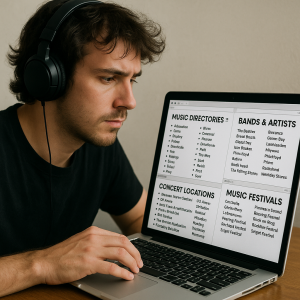How Fans Can Use Directories to Track Down Rare Live Performances
 For music fans, there’s something special about live performances. The raw energy, spontaneous moments, and unique interpretations make live recordings feel more intimate than studio tracks. But tracking down rare live performances—especially older or unofficial ones—can feel like hunting for buried treasure. That’s where directories come in.
For music fans, there’s something special about live performances. The raw energy, spontaneous moments, and unique interpretations make live recordings feel more intimate than studio tracks. But tracking down rare live performances—especially older or unofficial ones—can feel like hunting for buried treasure. That’s where directories come in.
Directories are essential tools for collectors, archivists, and devoted fans. Whether it’s a dedicated website, a user-run spreadsheet, or an old-school forum post, directories help fans locate, access, and catalog rare live recordings that aren’t on mainstream platforms. In fact, some Korean sources like 사이트모음 showcase just how valuable these collections can be for keeping track of hidden gems that might otherwise be lost.
Here’s how fans can use directories to find those elusive shows—and some tips for navigating this niche world.
What Is a Directory in This Context?
A directory, in this case, is any structured list or database that catalogs information about live performances. It might list:
- The date and location of a performance
- Setlists or song variations
- Recording quality or source
- Links to downloads or streams
- Notes about who recorded or uploaded the file
Directories can range from a fan-made Google Sheet to a comprehensive, searchable website with embedded audio players and metadata.
Why Use Directories?
Most rare live performances aren’t on Spotify, YouTube, or Apple Music. They’re often shared through niche sites, private collections, or bootleg archives. And unlike official releases, there’s usually no marketing or social media buzz around them.
Directories give you a map of what exists and where to find it. They help fans avoid dead ends and duplicate searches, and often include critical notes like, “Great soundboard recording—must-hear version of ‘So What’” or “Incomplete—missing final two songs.”
Where to Find These Directories
You’ll find directories in various formats and on multiple platforms. Here are a few key places to look:
1. Fan Forums and Message Boards
Sites like Steve Hoffman Music Forums, Phish.net, or Reddit’s r/LiveMusic often have pinned threads or archived posts where fans list and update performance data. These are goldmines of firsthand knowledge and usually point to harder-to-find recordings.
2. Dedicated Fan Sites
Some artists have fan sites that are better organized than their official pages. For example, Brucebase (for Bruce Springsteen) or U2gigs.com offer searchable directories of live performances with notes, setlists, and recording links. These are passion projects, often maintained by fans for decades.
3. Spreadsheet Archives
Don’t underestimate a good spreadsheet. Some fans maintain Google Sheets that track every known recording, often with separate tabs for dates, versions, and notes. These are usually shared in forums or social channels.
4. Torrent Communities
Private music torrent trackers, such as Dimeadozen or Traders’ Den, rely heavily on organized directories and tagging. Members upload shows with detailed descriptions, making it easier to filter by year, city, or song.
5. Archive.org
The Internet Archive has thousands of fan-recorded live shows—especially from jam bands like the Grateful Dead or indie acts who allow taping. The platform itself functions as a giant directory, and many fan-run directories link directly to it.
How to Use a Directory Effectively
Once you find a good directory, it helps to know how to work with it. Here are a few tips:
Search by Date or Era
Many directories are sorted chronologically. If you’re looking for a 1977 tour or a particular album cycle, start there. Some fans even break down tours by leg or continent, which makes it easier to zero in on specific areas.
Check the Source Info
Always look at the source: Was it recorded from the audience, a soundboard, or a radio broadcast? Audience recordings can be hit or miss, but some are surprisingly good. Soundboard and FM sources usually offer better quality.
Read the Notes
This is where directories shine. Notes from other fans can tell you what’s worth your time. Maybe there’s a rare cover played only once, or an improvised solo that made headlines in fan circles.
Respect the Sharing Rules
If the directory links to a private tracker or password-protected archive, follow the rules. These communities rely on trust and etiquette—leeching or resharing without proper credit can result in being banned or cut off from future uploads.
Tips for Finding Even Rarer Stuff
If the performance you’re hunting for isn’t listed, that doesn’t mean it doesn’t exist. Here’s how to dig deeper:
- Contact Collectors: Some fans have private collections they’re willing to share—especially if you have something to trade.
- Look for YouTube Sleepers: Some rare shows are uploaded under vague titles, such as “Live 1983 full concert.” Try searching by city, venue, or tour name instead of song titles.
- Use Setlist.fm: While not a directory of recordings, it helps you identify when and where a song was played live, which can lead you to a recording.
- Follow Niche Social Channels: Some fans post rare stuff on Tumblr, Instagram, or private Facebook groups.
- Join a Mailing List: Some tapers and collectors still use email lists to share updates. It’s old-school, but effective.
Final Thoughts
Directories are like treasure maps for music lovers. They don’t always lead straight to what you’re looking for, but they make the search possible—and often more rewarding. In the process of digging through listings, forums, and spreadsheets, you not only find rare recordings but also connect with the broader fan community that keeps this culture alive.
And that’s part of the magic—rare live performances aren’t just about the music. They’re about the stories, the search, and the people who care enough to preserve them.